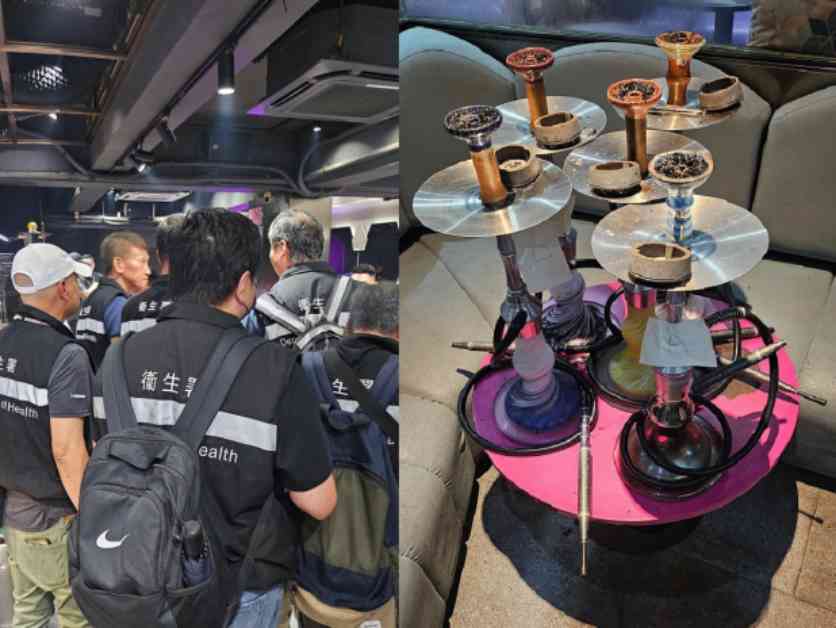Crackdown on Waterpipes in Tsim Sha Tsui
The Tobacco Control Office recently undertook a crackdown on the smoking of waterpipes, also known as shishas or hookahs, in Tsim Sha Tsui. This operation took place on a Friday night, with officers, including those in plain clothes, raiding a bar in the area. During this raid, 11 fixed penalty notices were issued to individuals found smoking waterpipes in the establishment. Each notice carries a penalty of HK$1,500. Apart from the individuals receiving penalties, the bar’s operators may also face prosecution under the Smoking (Public Health) Ordinance for aiding and abetting smokers.
The decision to target waterpipe smoking in this crackdown is not arbitrary. According to a spokesman from the Tobacco Control Office, waterpipe smokers are at a higher risk of inhaling toxins due to the deeper inhalation associated with this form of smoking. In fact, a typical one-hour session of smoking a waterpipe exposes the user to 100-to-200 times the volume of smoke inhaled from a single cigarette. This alarming statistic highlights the potential health risks posed by waterpipe smoking and underscores the importance of regulating its use.
Health Risks of Waterpipe Smoking
The practice of smoking waterpipes has gained popularity in recent years, especially among young adults seeking a social and cultural experience. However, the allure of waterpipe smoking comes with significant health risks that cannot be ignored. Apart from the increased intake of toxins compared to cigarette smoking, waterpipe users are also exposed to other dangers, such as carbon monoxide poisoning from charcoal burning and the unhygienic nature of the smoking apparatus.
One of the main concerns associated with waterpipe smoking is the misconception that it is a safer alternative to cigarette smoking. Many individuals believe that the water in the pipe filters out harmful substances, making the smoke less harmful. However, studies have shown that this is not the case. In reality, waterpipe smoke contains high levels of toxic compounds, including carbon monoxide, heavy metals, and carcinogens, which can have detrimental effects on the respiratory and cardiovascular systems.
Furthermore, the act of sharing a waterpipe with others can increase the risk of transmitting infections, such as tuberculosis, herpes, and influenza. The communal nature of waterpipe smoking, where individuals share the same mouthpiece, hose, and bowl, creates an ideal environment for the spread of infectious diseases. This is particularly concerning in the current global context, where the COVID-19 pandemic has highlighted the importance of maintaining good hygiene practices and minimizing close contact with others.
Regulatory Measures and Enforcement
In light of these health risks, it is imperative for regulatory authorities to take action to curb the prevalence of waterpipe smoking in public spaces. The recent crackdown by the Tobacco Control Office in Tsim Sha Tsui is a step in the right direction towards enforcing existing regulations and raising awareness about the dangers of waterpipe smoking. By issuing fixed penalty notices to individuals caught smoking waterpipes in bars, the authorities are sending a clear message that such behavior will not be tolerated.
Apart from penalizing individual smokers, it is essential to hold bar operators accountable for allowing waterpipe smoking on their premises. The Smoking (Public Health) Ordinance provides the legal framework for prosecuting establishments that facilitate smoking activities, including waterpipe smoking. By targeting both smokers and operators, the authorities can create a more effective deterrent against the practice of waterpipe smoking in public spaces.
Moving forward, it is crucial for the Tobacco Control Office to continue monitoring and enforcing regulations related to waterpipe smoking. This includes conducting regular inspections of bars, restaurants, and other establishments where waterpipes are commonly used. By maintaining a strong presence and taking swift action against violators, the authorities can protect the public from the harmful effects of waterpipe smoking and promote a healthier environment for all residents.
In conclusion, the crackdown on waterpipes in Tsim Sha Tsui is a significant step towards addressing the health risks associated with this popular form of smoking. By raising awareness about the dangers of waterpipe smoking, enforcing existing regulations, and holding individuals and establishments accountable for their actions, the authorities can safeguard public health and promote responsible behavior in society. It is essential for all stakeholders, including smokers, bar operators, and regulatory authorities, to work together towards creating a smoke-free environment that prioritizes the well-being of the community.



















